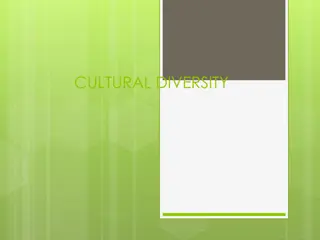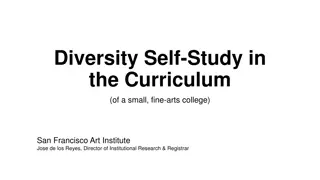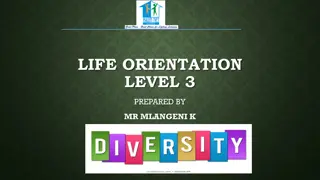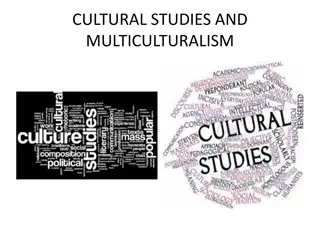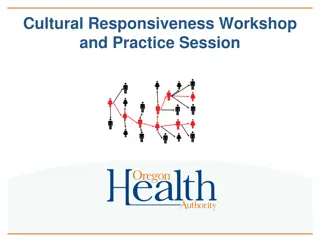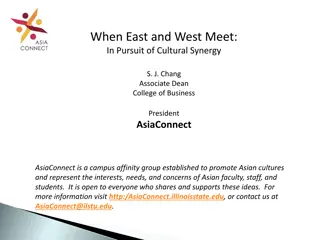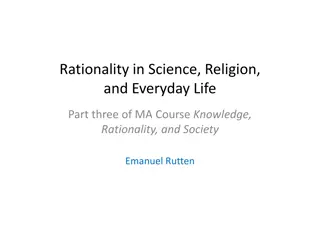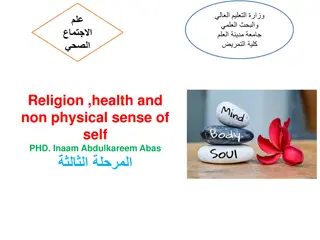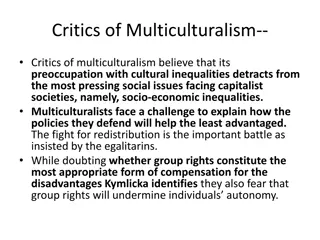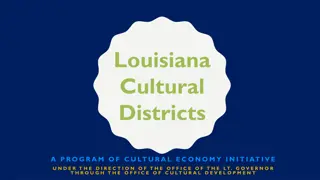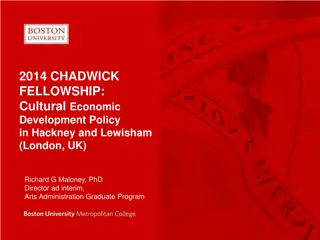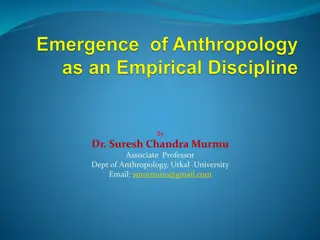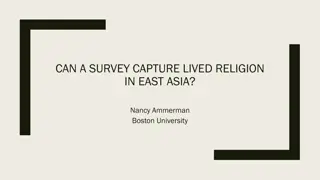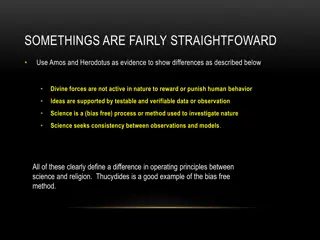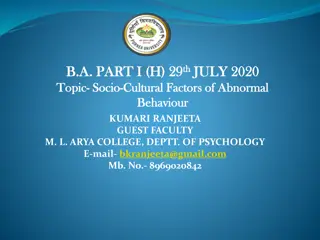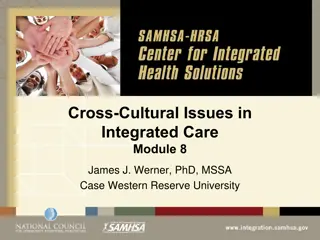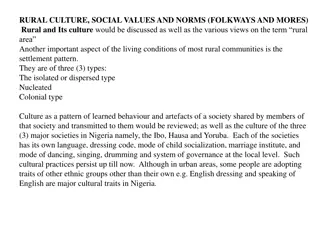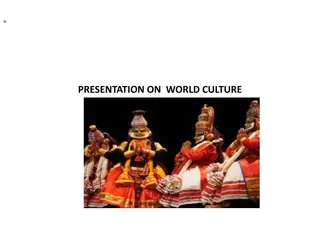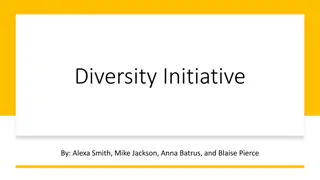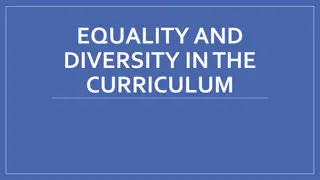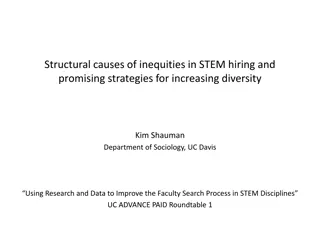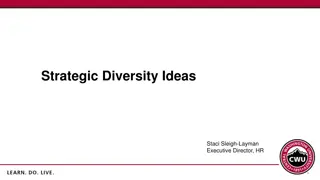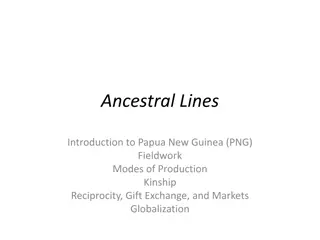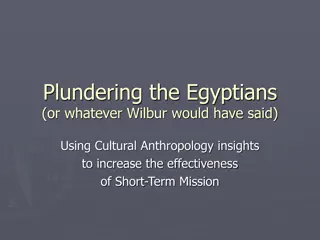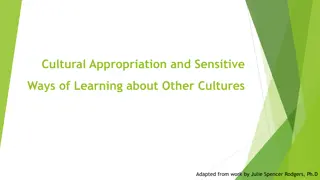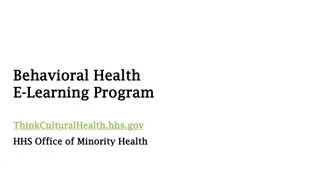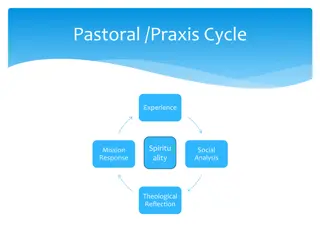Anthropological Study of Religion: Exploring Cultural Diversity
This chapter delves into the anthropological study of religion, emphasizing cultural relativism and holism. It explores various branches of anthropology, such as cultural studies and archaeology, and discusses the holistic approach anthropologists take when studying smaller populations to understand human universals and variations. The text also touches on the concept of variation within religions and provides insights into how anthropologists collect data through fieldwork and ethnography.
Download Presentation

Please find below an Image/Link to download the presentation.
The content on the website is provided AS IS for your information and personal use only. It may not be sold, licensed, or shared on other websites without obtaining consent from the author. Download presentation by click this link. If you encounter any issues during the download, it is possible that the publisher has removed the file from their server.
E N D
Presentation Transcript
THE ANTHROPOLOGICAL STUDY OF Chapter 1 RELIGION
INTRODUCTION People like to make sense of their world and explain occurrences They often use religious beliefs to do this We will study different religions using The comparative approach No judgment An open mind Cultural relativity A method that tries to find similarities Anthropology studies all aspects of being human It uses different perspectives Holism Holism (or being holistic): looks at integrated parts to get the whole picture
ANTHROPOLOGY Definition: the study of humankind Four branches: Cultural Studies culture, or learned, transmitted behavior of living people Archaeology Studies culture of past societies by analyzing artifacts Linguistic Studies study construction and evolution of language Physical/biological Studies relationship of biology and culture
HOLISTIC APPROACH Anthropologist study a narrow focus of a population for long periods of time They use participant observation participant observation We call small, traditional groups of people small instead of primitive primitive Examples: hunter/gatherers, nomads We study smaller populations to look for human universals universals and to study the range of variation in humans small- -scale scale human
VARIATION How many religions are there in the world? Is there variation within religions?
THE STUDY OF SOCIETIES How do anthropologists collect data? Fieldwork Fieldwork: moving to the society under study and immersing yourself in that culture Involves participant observation Ethnography Ethnography: a written account of how a human population lives We organize societies into cultural areas which societies tend to share cultural traits Examples: subsistence or technology Hunting and Gathering (aka HG or foraging) Agriculture (cultivation) Pastoralism (herding) Industrialism cultural areas: geographic areas in
ETHNOGRAPHIC EXAMPLE The Fore of New Guinea New Guinea, horticulturalists, 1950s Many suffered from unknown disease called kuru or shaking disease Affected women more
ETHNOGRAPHIC EXAMPLE Medical team needed to take holistic approach Discovered that disease was caused by prions Fore contracted prions by eating their relative s remains (especially brains) at funeral ceremonies Fore thought disease was from sorcery Do the Kore and Western doctors view this disease in the same way? How would this affect those with the disease?
https://encrypted-tbn1.gstatic.com/images?q=tbn:ANd9GcSo9Kan9q-rAswKOe8N2sA-dWs8uJqecjiTRmKaT2tqJoSjHKcjhttps://encrypted-tbn1.gstatic.com/images?q=tbn:ANd9GcSo9Kan9q-rAswKOe8N2sA-dWs8uJqecjiTRmKaT2tqJoSjHKcj
WAYS TO VIEW CULTURE An anthropologist (or any researcher) cannot be 100% objective Anthropology unlocked the answer of kuru, not medical knowledge Holism involves viewing something from the insider (emic emic) and outsider (etic etic) perspectives Both views provide a holistic picture Keep this in mind while reading the novel for this class
CULTURAL RELATIVISM It is difficult to not judge others cultural practices We have to be careful of ethnocentrism Belief that one s own culture is superior Can cultures or beliefs be superior/inferior? Take the stance of cultural relativism cultural relativism ethnocentrism
POSTMODERNISM Is it possible to understand the true meaning of another's culture or about the world? Cultural knowledge and viewpoints are social constructions There are multiple ways to see the world There are no right or wrong practices or beliefs We take a middle approach: Non-judgment is objective Postmodernism is subjective
NOVEL While reading the novel, work on the study guide (posted on portal) You want to pay attention to the different ways the family and Western doctors explain and treat the child s disease Look for examples of ethnocentrism and cultural relativism Try to see the story from both sides Ask yourself what you would do in that situation Quiz #1 is on March 13
HUMAN RIGHTS One main goal of anthropology is to study things in context What about human rights? Can we view a practice and understand its meaning but still think it is wrong? Cannibalism Revenge killings Infanticide Female genital mutilation
WHAT IS CULTURE? It is a complex whole Culture gives meaning to reality Culture Is not biological Is learned by living in that group Is shared by members of a group Accounts for differences between groups of people Based on symbolism Culture is highly variable and changes quickly
DEFINING RELIGION How do we define religion? Discuss with your group and come up with a simple definition of religion
DEFINING RELIGION How do we define religion? Use operant definitions operant definitions so we can observe and study religion We use analytic definitions analytic definitions to explain how it is expressed We use functional definitions functional definitions to explain social functions We us essentialist definitions essentialist definitions to show that much of the core parts of religion are extraordinary We use supernatural supernatural classifications to explain things not explained in the natural world
DEFINING RELIGION Worldview Worldview Perception of reality Explanations Explanations Social control Social control Concept of right and wrong/good and evil So, religion deals with The supernatural supernatural Not of this world The sacred sacred Things to be respected Animism Animism Belief in spirits Ritual Ritual Symbolic and repeated behavior
VIDEOS Next we ll watch two short videos on ancient religions As you watch, practice cultural relativity and comparative approach What aspects are similar between the two ancient religions?
EXAMPLES OF ANCIENT RELIGIONS Hammurabi Ancient Egypt https://www.khanaca demy.org/test- prep/ap-art- history/ancient- mediterranean- AP/ancient-near-east- AP/v/law-code-stele- of-king-hammurabi-- 792-1750-b-c-e https://www.khanaca demy.org/test- prep/ap-art- history/ancient- mediterranean- AP/ancient-egypt- AP/v/judgement-in- the-presence-of-osiris- -hunefer-s-book-of- the-dead
THE STUDY OF RELIGION One aspect of studying religion is to try to see what purpose the religion has
THEORETICAL APPROACHES 1. Evolutionary approach Evolution of culture (simple to complex) Animism Judgment and ethnocentrism 2. Marxist approach Religion is created by those in power opiate of the masses
THEORETICAL APPROACHES 3. Functional approach What is religion s role in society? Collective conscious Collective conscious, promotes social cooperation Gives society rules to be integrative Gives comfort or reason during hard times
THEORETICAL APPROACHES 4. Interpretive approach Make sense of culture by studying meaning Symbols represent things and direct human behaviors 5. Psychosocial approach Connection between society and the individual Freudian
BIOLOGICAL BASIS What we think is real is really a creation of our brains We get cues from the environment and our brains Can certain religious experiences be created by brain? Out of body experience, Talking in tongues Need to consider all aspects to be holistic
BELIEFS IN SPIRITS Most cultures believe in spirits Anthropomorphic Anthropomorphic means treating non-human things in a human way Theory of mind Theory of mind allows us to think we understand what other beings are feeling Empathy Critical for living in social systems This may lead into the supernatural Maybe a way to control or understand nature
EVOLUTION OF RELIGION Maybe it evolve as a way to ensure cooperation Or to enforce kinship Or to stabilize society and people s behavior Our cognition cognition sees two representations of the world: The physical The psychological We impose our hopes and desires onto things and can see what we want to see (even if it is not there)
RELIGIOUS BEGINNINGS? There is evidence that human ancestors had religious thought Homo heidelbergensis At least 600,000 years ago Buried dead Symbolic pink handaxe Homo neanderthalensis At least 250,000 years ago Buried dead Used flowers in graves
DISCUSSION QUESTIONS 1. Describe what it means to be holistic 2. Describe why it is important to have cultural relativism 3. Identify three religious ceremonies you have participated in 4. Do you think there is a biological basis for religious beliefs? Or is religion entirely social?
ASSIGNMENT Read Body Ritual of the Nacirema and work on questions in group






